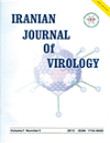Immune-Related Genes Expression in HIV-Infected Patients with Discordance in CD4+T-Cell Levels
Antiretroviral therapy (ART) should significantly improve the recovery of the immune system in Human immunodeficiency virus (HIV) infected patients. In some patients under ART, it was not possible to increase CD4+ cells reasonably in spite of effective virological control, which is known as discordant immune response (DIR). The aim of this study is the evaluation of the expression of C-X-C chemokine receptor type 4 (CXCR4), C-C chemokine receptor type 5 (CCR5), interleukin 12B (IL12B), cluster of differentiation 3(CD3), tumor necrosis factor alpha (TNFα), protein tyrosine kinase 2 beta (PTK2B), and t-cell receptor beta TCR β genes in patients with DIR.
In this case-control study, peripheral blood mononuclear cell (PBMC) specimens from patients of the two groups were isolated, RNA was extracted: patients of the control group who were immunologic responders and patients of the case group, which were non-immunologic responders. Real-time relative quantitative polymerase chain reaction (PCR) was performed in duplicate using One Step PrimeScript™ RT-PCR Kit and data analyzed by using GraphPad prism software version 8.0.2.
The expression levels in the patients of the case group in comparison with the patients of the control group were measured for CXCR4, CCR5, IL12B, TNF-α, CD3, PTK2B and TCR-β. The Fold change ratio for CCR5, TCR-β, and CD3 were (0.225), (0.12), (0.09), respectively, and in all three of them, a significant decrease was observed with confidence values. p <0.05, p <0.02 and p <0.01, respectively. None of the CXCR4, IL12B, TNF-α, and PTK2B was statistically significantly different and their fold change ratio was (1.01), (0.6), (1.04), and (0.718) respectively.
we showed significant decrease in the expression of CCR5, TCR-β, and CD3 genes in the patients of the case group in comparison with the patients of the control group, but we could not verify this low expression of these genes are the reason of the low CD4+ T-cell count. Further investigation is necessary, if the suppression of these genes can influence the proliferation or development of CD4 T cells, in-vitro.
- حق عضویت دریافتی صرف حمایت از نشریات عضو و نگهداری، تکمیل و توسعه مگیران میشود.
- پرداخت حق اشتراک و دانلود مقالات اجازه بازنشر آن در سایر رسانههای چاپی و دیجیتال را به کاربر نمیدهد.


